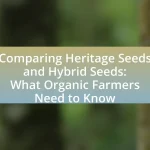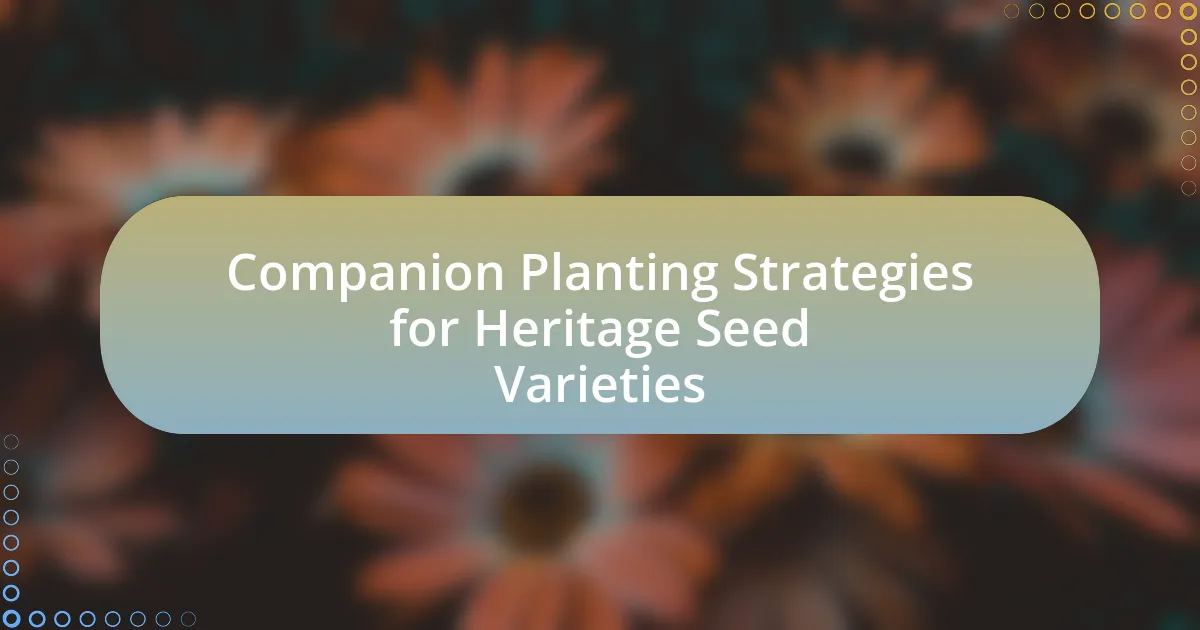Pest management techniques for heritage seed gardens focus on sustainable practices that protect biodiversity and the integrity of heirloom plants. Key strategies include integrated pest management (IPM), which combines biological, cultural, physical, and chemical methods, as well as the use of organic pesticides, companion planting, and cultural practices like crop rotation. These techniques address the unique challenges faced by heritage seed gardens, such as susceptibility to pests and limited resistance in traditional seed varieties. The article outlines the importance of tailored pest management approaches, the role of biodiversity, and effective identification and control methods for common pests, ultimately promoting healthier ecosystems and preserving valuable genetic resources.
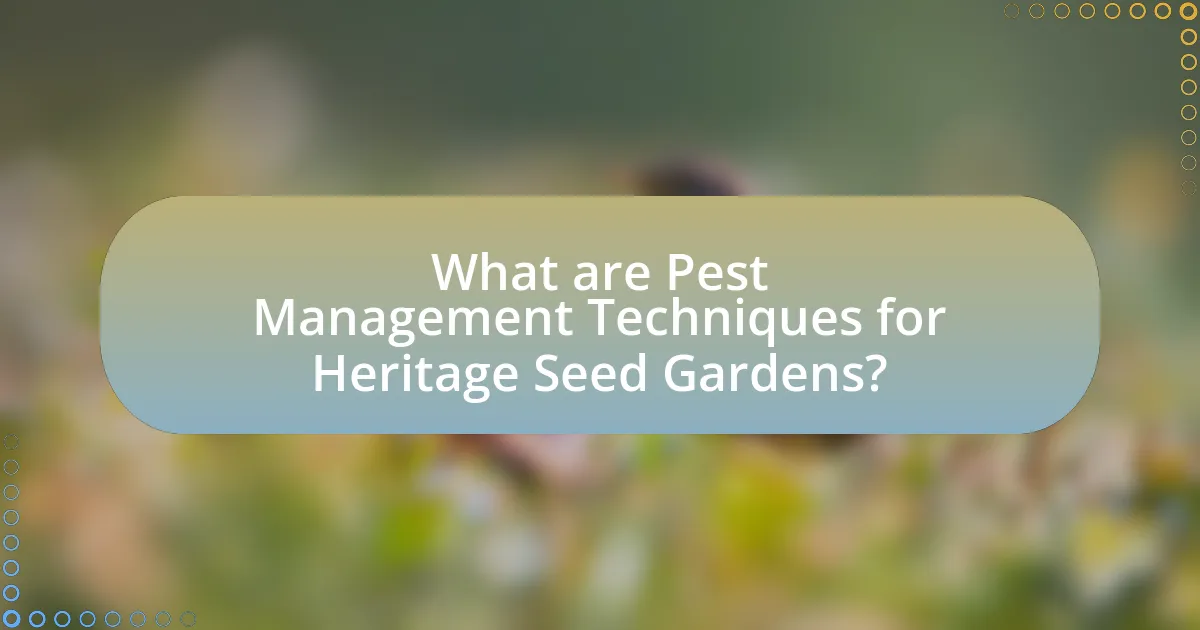
What are Pest Management Techniques for Heritage Seed Gardens?
Pest management techniques for heritage seed gardens include integrated pest management (IPM), organic pesticides, companion planting, and cultural practices. IPM combines biological, cultural, physical, and chemical tools to minimize pest damage while reducing risks to human health and the environment. Organic pesticides, derived from natural sources, are used to control pests without harming beneficial organisms. Companion planting involves growing certain plants together to deter pests or enhance growth, while cultural practices such as crop rotation and maintaining soil health help prevent pest outbreaks. These techniques are supported by research indicating that sustainable practices can effectively manage pests while preserving biodiversity in heritage seed gardens.
How do these techniques differ from conventional pest management?
These techniques differ from conventional pest management by emphasizing ecological balance and biodiversity rather than solely relying on chemical pesticides. Conventional pest management often prioritizes immediate pest control through synthetic chemicals, which can lead to resistance and environmental harm. In contrast, techniques for heritage seed gardens focus on integrated pest management (IPM), which combines biological control, cultural practices, and habitat manipulation to manage pests sustainably. For example, using companion planting and natural predators reduces pest populations while promoting soil health and ecosystem resilience. This approach not only protects the heritage seeds but also fosters a more sustainable agricultural practice.
What specific challenges do heritage seed gardens face regarding pests?
Heritage seed gardens face significant challenges regarding pests due to their reliance on traditional, non-hybrid seed varieties that may lack resistance to common pests. These gardens often cultivate a diverse range of heirloom plants, which can attract a wider variety of pests, making pest management more complex. Additionally, the organic practices typically employed in heritage seed gardens limit the use of synthetic pesticides, necessitating alternative pest control methods that may not be as effective. Research indicates that the lack of genetic diversity in some heirloom varieties can also lead to increased vulnerability to specific pest outbreaks, further complicating pest management efforts.
Why is it important to use tailored pest management techniques for heritage seeds?
Tailored pest management techniques for heritage seeds are crucial because they address the unique vulnerabilities and ecological requirements of these genetically diverse plants. Heritage seeds often possess specific traits that make them susceptible to certain pests and diseases, which can threaten their survival and the biodiversity they represent. For instance, traditional pest control methods may not be effective or could harm beneficial organisms that support the health of heritage seed varieties. Research indicates that customized approaches, such as integrated pest management (IPM), can enhance the resilience of heritage seeds by promoting natural pest predators and using organic treatments, thereby preserving both the seeds and the ecosystems they inhabit.
What are the key principles of pest management in heritage seed gardens?
The key principles of pest management in heritage seed gardens include prevention, monitoring, and intervention. Prevention involves implementing practices such as crop rotation, selecting pest-resistant varieties, and maintaining biodiversity to create a balanced ecosystem. Monitoring entails regularly inspecting plants for signs of pests and diseases, allowing for early detection and management. Intervention strategies may include the use of organic pesticides, biological control agents, and cultural practices that minimize pest impact. These principles are supported by research indicating that integrated pest management (IPM) approaches can effectively reduce pest populations while preserving the integrity of heritage seed varieties.
How does integrated pest management (IPM) apply to heritage seed gardens?
Integrated pest management (IPM) applies to heritage seed gardens by utilizing a combination of biological, cultural, physical, and chemical practices to manage pests while preserving genetic diversity. IPM strategies in these gardens focus on monitoring pest populations, promoting beneficial organisms, and implementing preventive measures that align with the ecological principles of heritage seed preservation. For instance, crop rotation and companion planting can enhance plant health and reduce pest incidence, thereby supporting the sustainability of heritage varieties. Research indicates that IPM can effectively reduce pesticide use by up to 50%, which is crucial for maintaining the integrity of heritage seeds that may be sensitive to chemical treatments.
What role does biodiversity play in pest management for these gardens?
Biodiversity plays a crucial role in pest management for heritage seed gardens by enhancing ecosystem resilience and promoting natural pest control mechanisms. A diverse range of plant species attracts beneficial insects, such as predators and parasitoids, which help regulate pest populations. For instance, studies have shown that gardens with higher plant diversity can reduce pest outbreaks by up to 50%, as these ecosystems support a wider variety of natural enemies that target specific pests. Additionally, biodiversity contributes to soil health and nutrient cycling, further strengthening plant defenses against pests.
What are the most common pests affecting heritage seed gardens?
The most common pests affecting heritage seed gardens include aphids, spider mites, and whiteflies. Aphids are known for their rapid reproduction and ability to transmit plant viruses, which can severely impact seed quality. Spider mites thrive in hot, dry conditions and can cause significant damage by feeding on plant sap, leading to leaf discoloration and drop. Whiteflies, on the other hand, also feed on sap and can weaken plants, making them more susceptible to diseases. These pests pose a threat to the integrity and viability of heritage seeds, necessitating effective pest management strategies to protect these valuable genetic resources.
How can gardeners identify these pests effectively?
Gardeners can identify pests effectively by observing specific signs of damage on plants, such as chewed leaves, discoloration, or wilting. Additionally, they can monitor for the presence of the pests themselves, which may include visible insects, webbing, or droppings. Utilizing tools like sticky traps and magnifying glasses can enhance detection. Research indicates that regular inspections and maintaining a pest diary can improve identification accuracy, as documented in the “Integrated Pest Management for Vegetable Crops” by the University of California Agriculture and Natural Resources.
What are the life cycles of these common pests?
The life cycles of common pests typically include four stages: egg, larva, pupa, and adult. For example, the life cycle of the cabbage worm begins with the female laying eggs on the underside of cabbage leaves. Once the eggs hatch, the larvae feed on the leaves, growing through several instars before entering the pupal stage, where they transform into adults. This cycle can take as little as three weeks, depending on environmental conditions. Similarly, aphids reproduce through a cycle that can include both sexual and asexual reproduction, allowing rapid population growth. Understanding these life cycles is crucial for effective pest management in heritage seed gardens, as it informs the timing of interventions to disrupt these cycles and minimize damage.
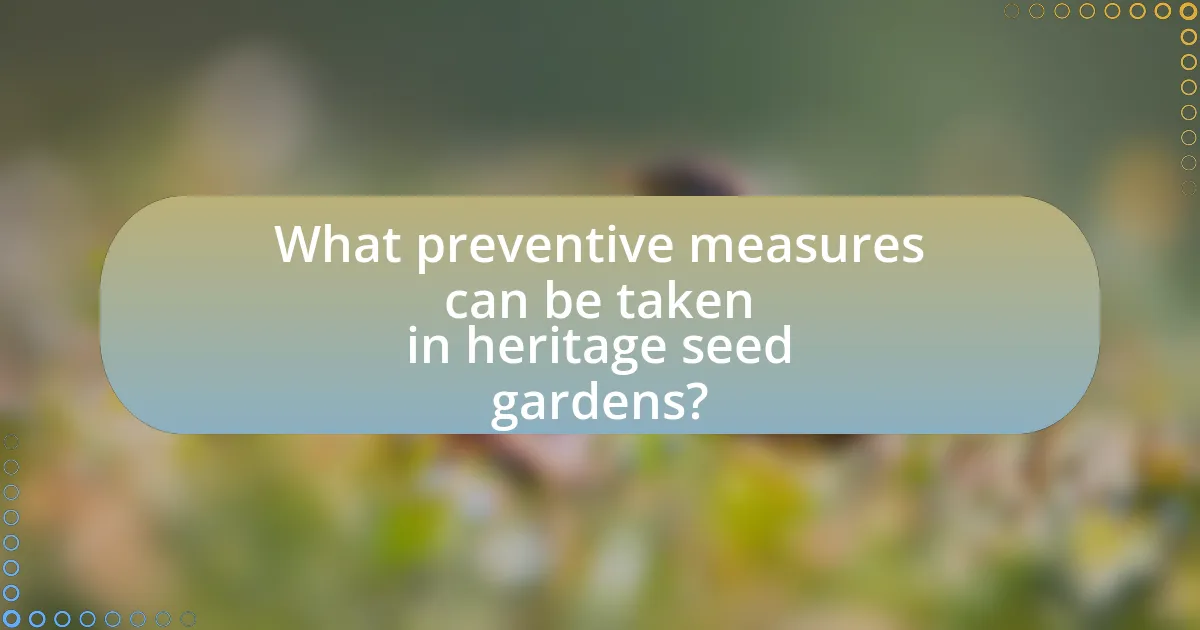
What preventive measures can be taken in heritage seed gardens?
Preventive measures in heritage seed gardens include implementing crop rotation, using companion planting, and maintaining soil health. Crop rotation disrupts pest life cycles and reduces disease incidence by alternating plant families, which minimizes the buildup of specific pests and pathogens. Companion planting involves growing mutually beneficial plants together, which can deter pests naturally; for example, marigolds can repel nematodes. Maintaining soil health through organic amendments and proper watering practices fosters robust plants that are more resilient to pests and diseases. These practices are supported by research indicating that diverse planting strategies and healthy soils significantly reduce pest populations and enhance plant vigor.
How can cultural practices help in pest management?
Cultural practices can significantly aid in pest management by promoting biodiversity and enhancing ecosystem resilience. Techniques such as crop rotation, intercropping, and the use of cover crops disrupt pest life cycles and reduce their populations. For instance, rotating crops can prevent the buildup of specific pests that thrive on particular plants, while intercropping can attract beneficial insects that prey on harmful pests. Research indicates that these practices can lead to a reduction in pest incidence by up to 50%, thereby minimizing the need for chemical interventions.
What planting strategies can reduce pest infestations?
Implementing crop rotation is a planting strategy that can significantly reduce pest infestations. By alternating the types of crops grown in a specific area, pests that are specialized to certain plants are less likely to establish themselves, as their food source is periodically removed. Research indicates that crop rotation can decrease pest populations by disrupting their life cycles and reducing their ability to reproduce. Additionally, intercropping, which involves planting different crops in proximity, can enhance biodiversity and attract beneficial insects that prey on pests, further mitigating infestations. Studies have shown that these strategies not only lower pest numbers but also promote healthier soil and ecosystems, making them effective for sustainable pest management in heritage seed gardens.
How does crop rotation benefit heritage seed gardens?
Crop rotation benefits heritage seed gardens by enhancing soil health and reducing pest populations. By alternating the types of crops grown in a specific area, soil nutrients are replenished, which improves plant vigor and resilience. For instance, legumes can fix nitrogen in the soil, benefiting subsequent crops. Additionally, rotating crops disrupts the life cycles of pests and diseases that thrive on specific plants, leading to lower infestations. Research indicates that farms employing crop rotation experience a significant decrease in pest-related damage, thereby promoting a healthier ecosystem for heritage seeds.
What physical barriers can be implemented to protect heritage seeds?
Physical barriers that can be implemented to protect heritage seeds include row covers, fencing, and netting. Row covers create a protective layer over plants, shielding them from pests while allowing sunlight and moisture to penetrate. Fencing can deter larger animals such as deer and rabbits from accessing the seed garden, while netting can prevent birds and insects from damaging the plants. These barriers are effective in reducing pest damage, thereby preserving the integrity of heritage seeds.
How effective are row covers and nets against pests?
Row covers and nets are highly effective against pests, providing a physical barrier that prevents insects from reaching plants. Studies have shown that using row covers can reduce pest damage by up to 90%, particularly against common threats like aphids and cabbage worms. Additionally, nets can protect crops from larger pests such as birds and rabbits, further enhancing their effectiveness in pest management. The use of these barriers not only minimizes the need for chemical pesticides but also supports sustainable gardening practices, making them a valuable tool in heritage seed gardens.
What are the best practices for maintaining these barriers?
The best practices for maintaining barriers in heritage seed gardens include regular inspections, proper installation, and timely repairs. Regular inspections help identify any damage or wear that could compromise the barrier’s effectiveness against pests. Proper installation ensures that barriers are securely placed to prevent pest entry, while timely repairs address any issues before they escalate, maintaining the integrity of the barrier. Research indicates that barriers can reduce pest populations by up to 80% when properly maintained, highlighting the importance of these practices in effective pest management.
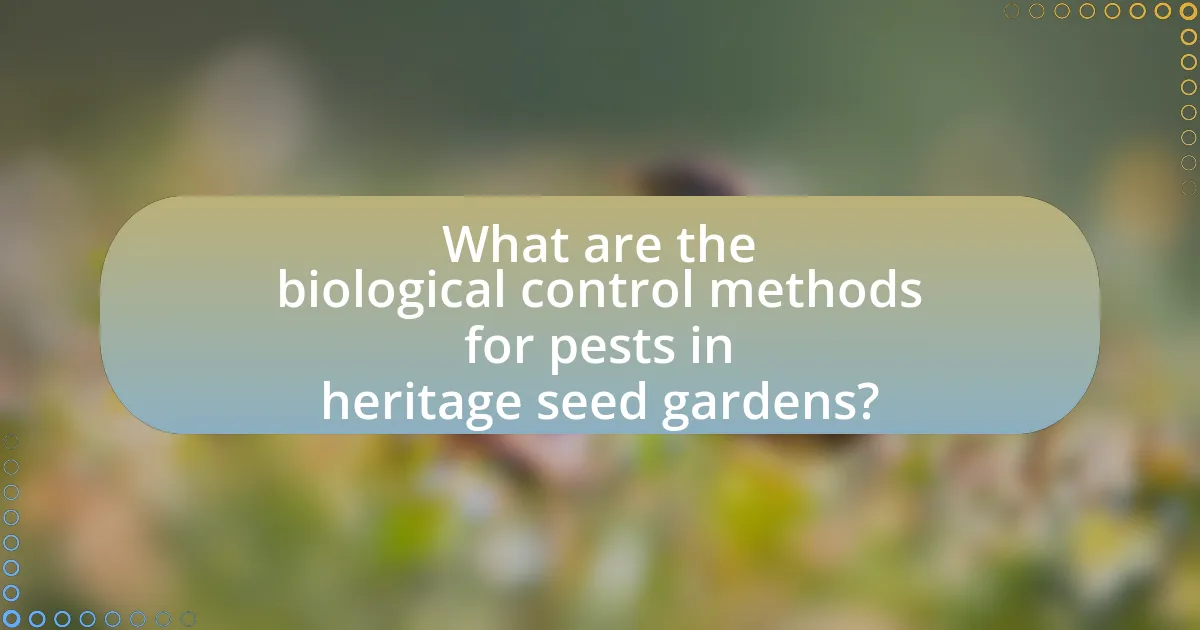
What are the biological control methods for pests in heritage seed gardens?
Biological control methods for pests in heritage seed gardens include the use of beneficial insects, microbial agents, and natural plant extracts. Beneficial insects, such as ladybugs and lacewings, prey on common pests like aphids and caterpillars, effectively reducing their populations. Microbial agents, including Bacillus thuringiensis, target specific pests while being safe for plants and non-target organisms. Additionally, natural plant extracts, such as neem oil, can deter pests and inhibit their growth. These methods are supported by research indicating their effectiveness in sustainable pest management, promoting biodiversity and minimizing chemical pesticide use in heritage seed gardens.
How can beneficial insects be utilized in pest management?
Beneficial insects can be utilized in pest management by introducing natural predators and parasitoids that target specific pest populations. For example, ladybugs effectively control aphid infestations, while lacewings can reduce populations of various soft-bodied insects. Research indicates that the presence of these beneficial insects can lead to a significant decrease in pest numbers, enhancing crop health and yield. A study published in the journal “Biological Control” demonstrated that fields with higher populations of beneficial insects experienced up to 50% less pest damage compared to those without. This evidence supports the effectiveness of integrating beneficial insects into pest management strategies for sustainable agriculture.
What types of beneficial insects are most effective for heritage seed gardens?
Ladybugs, lacewings, and parasitic wasps are the most effective beneficial insects for heritage seed gardens. Ladybugs are known for their voracious appetite for aphids, which can damage plants, while lacewings also target aphids and other soft-bodied pests. Parasitic wasps, such as those from the family Braconidae, lay their eggs in or on pest insects, effectively controlling their populations. Research indicates that these beneficial insects can significantly reduce pest numbers, thereby promoting healthier plants and improving seed quality in heritage seed gardens.
How can gardeners attract these beneficial insects?
Gardeners can attract beneficial insects by planting a diverse range of flowering plants that provide nectar and pollen. Specific plants such as dill, fennel, and yarrow are known to attract predatory insects like ladybugs and lacewings, which help control pest populations. Research indicates that a variety of flowering plants can increase the presence of these beneficial insects, enhancing biodiversity and pest management in gardens.
What role do microbial and botanical pesticides play?
Microbial and botanical pesticides play a crucial role in sustainable pest management by providing environmentally friendly alternatives to synthetic chemicals. These pesticides utilize naturally occurring microorganisms and plant extracts to target specific pests while minimizing harm to beneficial organisms and the ecosystem. For instance, Bacillus thuringiensis, a microbial pesticide, effectively controls caterpillar pests without affecting non-target species. Additionally, botanical pesticides like neem oil disrupt pest life cycles and repel insects, contributing to integrated pest management strategies that promote biodiversity and soil health in heritage seed gardens.
How do these alternatives compare to chemical pesticides?
Alternatives to chemical pesticides, such as biological control, cultural practices, and organic pesticides, generally offer a safer and more environmentally friendly approach to pest management. These alternatives reduce the risk of chemical residues in food and the environment, while also promoting biodiversity and soil health. For instance, studies have shown that biological control methods can effectively manage pest populations without the negative side effects associated with synthetic chemicals, such as resistance development and harm to non-target species. Additionally, organic pesticides often have lower toxicity levels compared to conventional chemical pesticides, making them safer for both humans and beneficial organisms.
What are the best practices for applying microbial and botanical pesticides?
The best practices for applying microbial and botanical pesticides include selecting the appropriate product for the target pest, ensuring proper timing of application, and adhering to recommended application rates. Selecting a product that specifically targets the pest while being safe for beneficial organisms is crucial; for instance, using Bacillus thuringiensis for caterpillar control minimizes harm to pollinators. Timing is essential, as applying these pesticides during the pest’s active life stage increases effectiveness; research indicates that applications during early morning or late afternoon can reduce evaporation and enhance adherence to plant surfaces. Following the manufacturer’s guidelines on application rates ensures optimal efficacy and minimizes potential phytotoxicity. Additionally, integrating these pesticides into a broader integrated pest management strategy, which includes monitoring pest populations and employing cultural practices, can enhance overall pest control effectiveness.
What are the challenges of implementing pest management techniques?
The challenges of implementing pest management techniques include the complexity of pest ecosystems, the need for specialized knowledge, and the potential for resistance development in pests. Pest ecosystems are often intricate, with multiple species interacting, making it difficult to predict outcomes of management strategies. Additionally, effective pest management requires expertise in entomology and ecology, which may not be readily available to all practitioners. Furthermore, pests can develop resistance to management techniques, leading to reduced effectiveness over time, as evidenced by studies showing that over-reliance on specific pesticides can result in resistant pest populations.
How can gardeners overcome resistance to pest management strategies?
Gardeners can overcome resistance to pest management strategies by implementing an integrated pest management (IPM) approach that combines multiple tactics. This method includes rotating pest control methods, using resistant plant varieties, and applying biological control agents, which collectively reduce the likelihood of pests developing resistance. Research indicates that IPM can decrease pest populations by up to 90% while minimizing chemical use, thereby enhancing the effectiveness of pest management strategies over time.
What are the common misconceptions about pest management in heritage seed gardens?
Common misconceptions about pest management in heritage seed gardens include the belief that organic methods are ineffective, that all pests must be eradicated, and that chemical pesticides are always necessary. Many assume organic pest control lacks efficacy; however, studies show that integrated pest management (IPM) strategies can effectively manage pests while preserving biodiversity. Additionally, the notion that complete pest elimination is required overlooks the ecological balance, as some pests can be beneficial. Lastly, the reliance on chemical pesticides is often overstated; research indicates that many heritage seed gardeners successfully use natural deterrents and companion planting to manage pests without chemicals.
What are the best practices for effective pest management in heritage seed gardens?
Effective pest management in heritage seed gardens involves implementing integrated pest management (IPM) strategies that prioritize prevention, monitoring, and control. Key practices include selecting pest-resistant seed varieties, maintaining biodiversity to attract beneficial insects, and employing crop rotation to disrupt pest life cycles. Regular monitoring for pest populations allows for timely interventions, while the use of organic pesticides, such as neem oil or insecticidal soap, can effectively manage outbreaks without harming the ecosystem. Research indicates that these practices not only protect the integrity of heritage seeds but also promote sustainable gardening methods, ensuring long-term viability and resilience against pests.
How can regular monitoring improve pest management outcomes?
Regular monitoring enhances pest management outcomes by enabling timely detection and intervention against pest populations. This proactive approach allows for the identification of pest presence before they reach damaging levels, facilitating targeted treatments that minimize crop loss. Research indicates that farms employing regular monitoring practices can reduce pest-related damage by up to 30%, as timely actions prevent infestations from escalating. Additionally, consistent monitoring helps in assessing the effectiveness of pest control measures, allowing for adjustments based on real-time data, which further optimizes pest management strategies.
What resources are available for gardeners seeking to enhance their pest management techniques?
Gardeners seeking to enhance their pest management techniques can access a variety of resources, including university extension programs, online databases, and pest management guides. University extension programs often provide research-based information tailored to local conditions, while online databases like the Integrated Pest Management (IPM) website offer comprehensive pest identification and management strategies. Additionally, guides such as “Pest Management for Organic Crops” by the USDA provide specific techniques and practices that are effective in managing pests while preserving the integrity of heritage seed gardens. These resources are validated by research and expert recommendations, ensuring that gardeners can implement effective pest management strategies.


